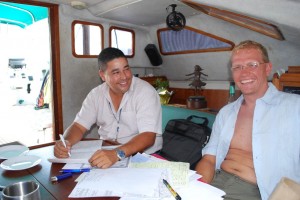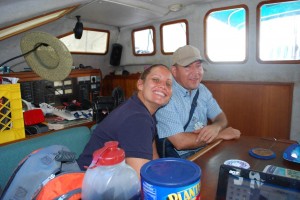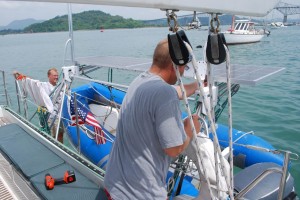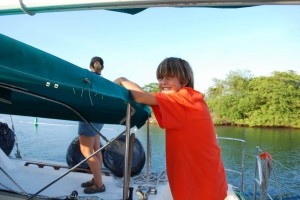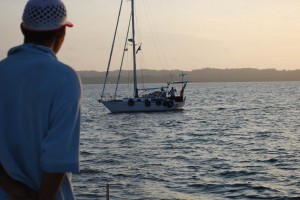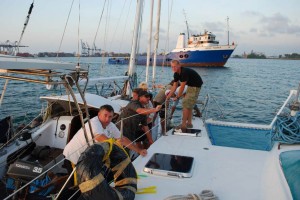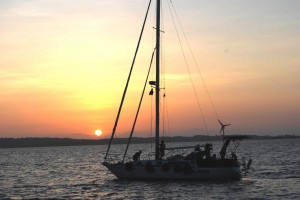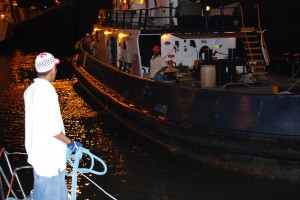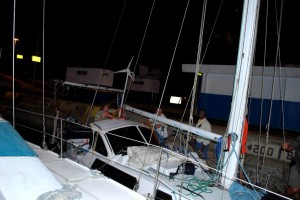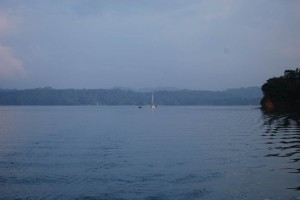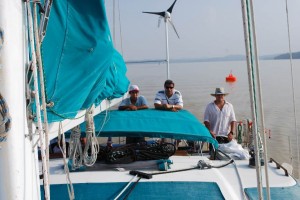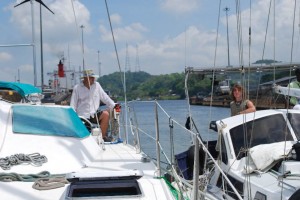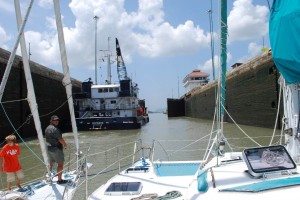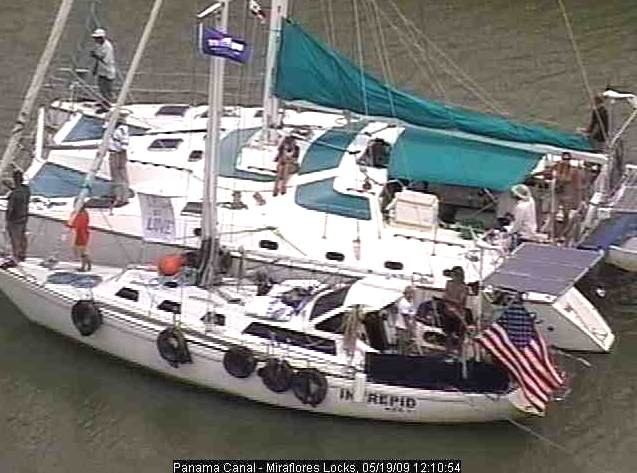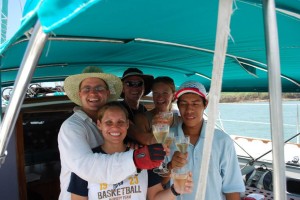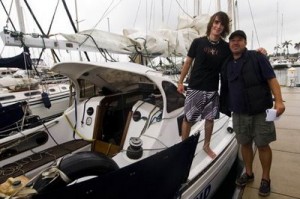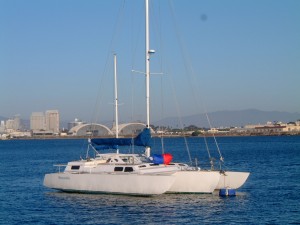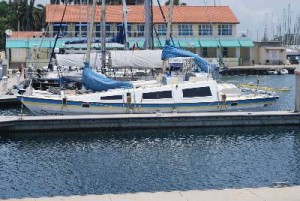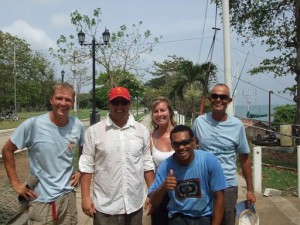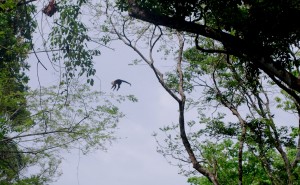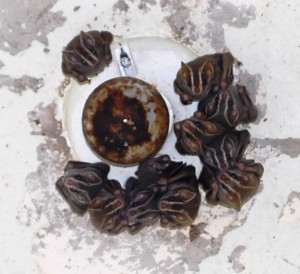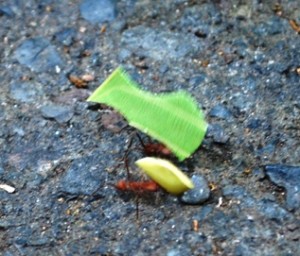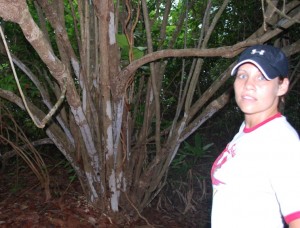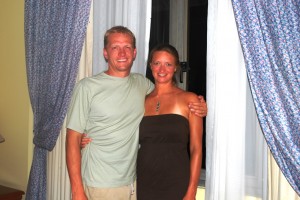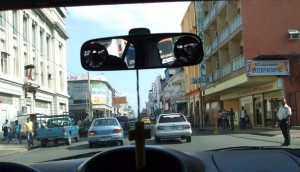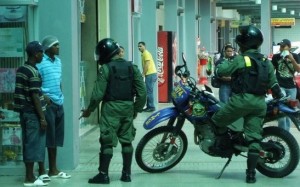Wednesday was yet another great day. It started out a little rushed, as Dallas was concerned that we would not have time to visit the port authority office as well as the French Embassy by noon when the woman responsible for visas finishes work. (A 20-hour work week seems quite cushy even for the French!) However, just after we finished breakfast, two men from the port authority office arrived to clear us in, saving us the hassle of making the trip to their office. The men were very amiable and seemed pleased that we had our paperwork in order and that Dallas and Wes could converse with them in Spanish.
Then it was on to Panama City via the free water taxi and $5 cab. Initially we drove through a poorer area of town as evidenced by the run-down condition of the homes and buildings, but it was clearly more orderly than Colon–no one walked in front of the cab, there were traffic signals, and I don’t remember seeing graffiti/airbrushing all over the place. We then found ourselves in an old but very well maintained district (el Casco Antiguo) with Spanish architecture, flowers hanging from balconies, and historic monuments. This was the most aesthetically pleasing place that I had seen since Old Town in Key West, and I welcomed the change of scenery.
As we got out and proceeded into the French Embassy, I mentally prepared to state what we needed in French, but as it turns out, the staff spoke English rather well. After waiting in the air conditioned waiting room for 20 minutes using the embassy’s reading materials to brush up on my French, we learned that it could take as long as 2 weeks to get an extension for our 30-day tourist visa for French Polynesia. We don’t have that kind of time to wait, so we will just have to find a way to get to Tahiti to obtain an extension (or prolongation, as the woman at the embassy called it) before our 30 days are up. We will most likely catch a plane or charter boat to Tahiti and back to our boat rather than sailing there, as everything we have heard suggests that we are going to want to spend much more than 30 days in the Marquesas, the easternmost island group of French Polynesia.
Upon leaving the embassy, we walked around for a bit looking for an internet cafe. We stopped in a convenience store for some bottled water, and Wes surprised us with ice cream sandwiches–a very nice treat. After asking several people, all of whom were friendly, we found our way to the internet cafe near Santa Ana Plaza. Wes and Tiff located their next destination, a store that sold a specific cable that Wes needed for his computer. Dallas and I opted to explore the area a bit and located a store that will be perfect for final provisioning. It is very similar to Walmart with the exception of a section called “Esoterica” that contained various soaps and lotions designed for enhancing one’s fortune or sex life (souvenirs, anyone?).
We then headed back toward the historical area and found ourselves at el Museo del Canal Interoceanica. We were told that the displays were all in Spanish but stopped in anyway since it was only $2/person. Three hours later, we had learned quite a lot about the history of the Panama Canal! Dallas managed to translate almost all of the key points for me (so we think), and the pictorial exhibits helped to convey the story as well. In a nutshell, international interest in the isthmus of Panama dates back to the 1500’s as a result of its geographical location and potential to greatly expand global commerce. Initially (circa 1855), an American company created a railroad that extended across the isthmus, providing another means for ’49ers to travel to California. However, it was not ideal for commerce, and thus, discussions continued regarding where to dig a canal. The American engineers apparently favored a route across the 200+ mile stretch between Columbia and Nicaragua, as there was a large lake there already. However, the Frenchman Ferdinand de Lesepps, who was credited with the creation of the Suez Canal, preferred the short (33 mile) Panamanian route and used his credibility and bravado to convince other French companies to buy in.
Digging began in 1880 without sufficient study of the geology of the region. There were serious, unanticipated problems right off the bat. Clearing the jungle was extremely labor intensive. Further, workers began to perish as a result of diseases such as malaria, which they did not realize was carried by mosquitoes. De Lesepps did not reveal these difficulties to his funders, however, until they had lost over 20,000 workers and had no choice but to abandon the project.
American companies took over at the turn of the century and were able to address the medical problems plaguing the canal workers. The project became political in 1903 when the Panamanians requested help from the U.S. in order to gain independence from Columbia. The Americans agreed to assist with the U.S. Navy for a price…possession of the Canal Zone when completed. Over the next 10 years, Americans sent over 7,000 men and women to the Canal Zone to work alongside Panamanians, Europeans, and Africans from the Caribbean region to complete the project. (This explains the racial diversity that exists here today.) Enough land was dug out of the canal to create 63 Egyptian pyramids or a pave a track around the world three times!
While this may sound like cause for good relations between the U.S. and Panama, the exhibits revealed that there was anti-American sentiment for a couple of reasons. First, the Americans working on the Canal were termed the “Gold Class” as they had nicer accomodations, better salaries, and more amenities than the “Silver Class” (everyone else). Second, the Americans had a military presence in the Canal Zone to protect their possession of the area and established their own laws and courts that gave them the right to expel people from the area. Panamanians began to organize demonstrations against the American occupation in the late 1940’s, and these continued and became more violent until the 1970’s when President Johnson made some concessions in terms of voiding the 1903 treaty and allowing Panamanians to share control of the Zone. The Canal Zone was returned to Panama in 1999, but to me, the influence of American culture still remains in terms of gender equality (e.g., we saw as many female police officers as male ones that first day in Colon) and entrepreneurial spirit (e.g., our advisor for the Canal transit told me that he wanted to start a bottled water company).
Dallas and I were pleased that it had stopped raining by the time we left the museum and popped into a souvenir shop to get a couple of crafts made by the nearby Kuna Indian tribe. We then explored our options for dinner and settled on an open-air restaurant called Buzio’s that played really good Brazilian music. All of the food was excellent, and Dallas the vegetarian was enticed to sample my red snapper with mediterranean vegetable sauce, which he seemed to really like!
We headed back to the Balboa Yacht Club where the boat is moored and found Zac and his entourage there at the restaurant. There were 10 minutes left before happy hour ended (this seems to be a global phenomenon), so we ordered a couple of pitchers of the local Balboa beer (pretty good) and enjoyed some more great conversation. Zac had to leave at one point to skype with a reporter from CNN (http://ac360.blogs.ncc.com/2009/05/21/sailing-around-the-globe). He stays pretty busy while in port!
As I’m sure you can tell, we are really enjoying this side of Panama. It feels great to be in the Pacific, as if we have accomplished something. In actuality, we have only traversed about 5% of the world, though, so we have a long way to go! We are planning to stay here for just a couple more days before heading to the Las Perlas for a day of scuba diving. Dallas was pretty sick yesterday but seems to be doing much better today, as he and Wes have already managed to install the two new solar panels that were delivered to us here in Balboa. Tiffany and I are trying to talk them into visiting the local discoteca tonight…we’ll let you know how that goes!
Sorry for the late blog update, but we’ve been having a great time ever since we left Shelter Bay. We left the marina just after Intrepid at about 17:30 on Monday to meet so that we would have plenty of time to get to the flats (anchorage area F in Limon Bay) where our advisors were scheduled to board at 18:45. In addition to the four of us, we also had on board Maximo, our Panamanian line handler, Zac’s dad Laurence, Zac’s videographer Brett, Zac’s photographer Jen, and Rosemary with her son David, who are on the beautiful boat Nina at Shelter Bay and were line handlers for Zac. The boat carrying the advisors came fairly quickly after we reached the flats so we transferred Zac’s crew for the transit to his boat and we headed for Gatun Locks, the first set of three chambers that would raise us the approximately 85 feet to the level of Gatun Lake. The advisors are like pilots but for small yachts. They all have a day job and work transits on their day off. Our advisors for both days were great – friendly, knowledgeable, informative, helpful, and even humorous.
Prior to reaching Gatun Locks we rafted up by tying four lines between Pura Vida and Intrepid (one bow, one stern, and two spring lines), with Intrepid on our port side so that our helm station was nearer to Zac’s cockpit to facilitate communication. Zac has a (long) tiller, by the way, instead of a wheel and also has a sizeable hard dodger, so he’s perfected the art of steering under power while standing on the cockpit lazerette (seat/locker) and working the engine throttle with his foot, which is fun to watch. The advisors informed us that we would be going through Gatun Locks tied to an ACP (Panama Canal Authority) tug, which is generally the easiest way to transit.
There was a pretty large ship in the locks ahead of us (I’d guess 600+ feet), then the tug tied up with its starboard side at the edge of the locks. We tied up with Pura Vida’s starboard on the tug’s port side and Intrepid’s starboard on our port side. We found this to be a very easy way to transit. The only adventure came when we unrafted from the tug so that it could move from the first to the second chamber. We hadn’t perfected the art of controlling our rafted boats in tight quarters and the powerful tug took off with enough throttle that we were pushed in to the port chamber wall. Luckily, Zac had plenty of well-placed tires and there was no damage. We discussed rafted motoring techniques while the water was filling the second chamber and the advisors asked the tug to take off a little more slowly, so we had no problems leaving the second and third chambers.
It was dark by time we reached the mooring buoys in Gatun Lake where both boats tied up to the same buoy. Lauren & Tiff had volunteered to provide dinner for everyone Monday night and had cooked two pans of lasagna (mmmmm!!!). They started heating it up as soon as we left the third chamber and plates of warm lasagna, salad, and garlic bread starting coming up from the galley within minutes of both boats being tied up! During dinner, there was a total of 13 people eating aboard Pura Vida with plenty of space for everyone (the Privilege cockpit, one of our favorite features, definitely paid off). The food was delicious and the drinks were flowing with everyone enjoying themselves in conversation. There were many good stories to share as everyone except our line handler has interesting offshore and traveling experience. For example, Brett has circumnavigated twice and spent four and a half years sailing in the South Pacific, so he had lots of good stories and advice for us. When we finally knocked off at almost 2 am, everyone except Zac crashed on Pura Vida (we slept 10 even with both aft bunks full of tools & gear). Wes managed to get in a quick nocturnal dip in the fresh water lake before bed, which is a tradition enjoyed by transiting yachties in spite of the large crocs that inhabit the area.
We were expecting to be awakened by the howler monkeys, which make the most amazing beast-like growls/yells in the morning, but at ten till six in the morning, Laurence & Brett, who were sleeping the the tramps, hollered down below that the pilot boat was nearing us. That was a little earlier than expected, but we crawled out of our bunks and were underway shortly after 6 am. Pura Vida had new advisor, Lorenzo, who was great, and Intrepid actually had the rare experience of getting the same advisor for the second day. He joked that he had come back to return our fork, which we’d sent with him when the boat to pick up the advisors the night before had arrived before he’d had a chance to finish his dinner.
Most of the second day transiting the canal is pretty boring when you’re doing it for the second time as Wes and I were, although it’s still exciting to do it in your own boat. David taught us a new card game called Bob on the way while we moored at Gamboa waiting for Intrepid to close the distance between us. While at Gamboa, Lorenzo pointed out a massive crane at the ACP facility. He explained that the US had taken it from Germany after World War II as part of “the price of war” and brought it to Panama where it was later sold to the Panamanians for something like $1. Although it looks too big for the task, the floating crane is moved into the locks to service the chamber gates. It lifts the hollow gates, when are then filled with air and sealed. Once the gates are sealed, they are floated on the water and are pushed by tug to Colon for service. As the ACP doesn’t have any extra gates, the whole operation must be done very efficiently to minimize the down time for one of the two canal lanes.
After motoring through Gatun Lake and the Culebra cut with Wes at the wheel we came to the Pedro Miguel Lock (one down-chamber) at about 11:30. This time we were in the chamber with only a relatively small ACP powered crane barge, so we were nested center-chamber in a short chamber — intermediate chamber gates were used that made it smaller than the standard 1000ft x 110ft. We stayed rafted up with Intrepid to motor the short distance to the Miraflores Locks with its two down-chambers that would bring us into the Pacific. The down locks are usually a relatively boring affair after the up locks, but they were made a bit more interesting for us because we were handling our own lines for the first time. Also, there were several camera crews and photographers at the Miraflores Locks to cover Zac’s transit. The canal is truly an amazing feat of engineering and construction. It’s difficult to imagine the landscape before the Chagres River basin was dammed & flooded, the locks moving millions of gallons of water for each transit without pumps (just gravity), and the canal operating since it opened without any stoppages (of both lanes).
We handed Zac one of our air horns to blow when the last set of gates opened and it was our turn to motor out of the locks and into the Pacific. The red and green channel markers were now on the opposite side of the channel as we made the traditional champagne toast associated with transiting between the oceans.
After the advisors disembarked, we headed for a mooring at Balboa Yacht Club and Intrepid headed for Flamenco Marina. We had just tied up on our mooring at the edge of the mooring field when Intrepid passed us on the way to Flamenco. All in all, a pretty good day. Our engines carried us all the way across the Canal with no problems, and we are finally in the Pacific. The skyline of Panama City, with its 3+ million inhabitants was quite a change after being buried in the jungle at Shelter Bay. The area we’re moored at was formerly part of the Canal Zone and is now primarily a tourist area, so after dinner at the Yacht Club, Lauren and I were able to enjoy a nice walk of a couple miles or so down the causeway to the group of three islands at the end where there are numerous stores and shops, two anchorages, and Flamenco Marina. After all of that, we were confident that we would sleep well despite the very large container ships passing by our mooring on their way to the Canal.
We are finally ready to transit the Panama Canal today! Our final trips to Colon have gone fairly smoothly, although when we went to pay the transit fees, we discovered that they were tacking on extra charges to the tune of $500 or so. This was due to the fact that we had said that we could not go 8 knots and thus were scheduled for a 2-day rather than 1-day transit. We thought this was odd given that all other boats that we had heard about that are similar in size and even slower than us (because they are monohulls) were going through in 2 days but were not paying the extra fees. Dallas then realized that the Panamanian agents who typically handle the paperwork for cruisers just say that all of the boats can go 8 knots even though they cannot because all are doing 2-day transits now (and thus do not have to actually go 8 knots). So…we went back and changed our paperwork to state that we can in fact go 8 knots. We did so with a little reluctance, since we are not too sure if that is possible, but since then, we have confirmed that it won’t be necessary, so we are in the clear.
The oil pressure regulator arrived on time, and after Dallas quickly installed it, the port engine ran for 15 minutes without a problem. Other final tasks such as patching up the dinghy and repairing wiring for the bilge pumps (yet again) have gone smoothly as well. We seem to be ship-shape for the 10 day passage to the Galápagos!
The most (or should I say only) exciting news that we have to share is that we have befriended a young celebrity here in the marina. As I noted in the last blog, Zac Sunderland is attempting to be the youngest solo circumnavigator, and since he is on the last leg of the journey back to California, he is well on his way to accomplishing this goal. Zac’s father, Lawrence, met him here in the marina as he has been doing throughout Zac’s trip around the world, and we have enjoyed listening to he and Zac share tales of their adventures. (You can read them for yourself on Zac’s website, www.zacsunderland.com, which gets over 100,000 hits per day!) They were interested in hearing what Dallas had learned from his trip through the Canal aboard Dragon and asked if we would like to transit the Canal rafted up to Zac’s boat, Intrepid. We readily agreed! Zac’s personal photojournalist, Jen, will be joining him of course, so we will be celebrities (by proxy) for the day!
We leave this afternoon (16:00) to transit the first set of locks at Gatun Lake where we will spend the evening anchored. Tomorrow we will pass through the remaining two locks that end with the Miraflores Lock where the webcam is. We are expecting to be there around noon tomorrow but will try to post a quick blog to let readers know what time in case you would like to take a look. When the transit is completed, Zac’s crew will be jumping over to our boat so that Zac can sail to the anchorage on his own.
That’s all for now. Our next blog will be written from the Pacific Ocean!
Well, once again we have spent more time than originally planned in port. This time our delay has not been the result of major repairs to be made, but rather, the need to wait on the arrival of a basic $30 part (an oil pressure regulator valve) to complete a minor but necessary repair of the port engine. Waiting is frustrating, of course, but we have been keeping pretty busy, engaging in some fun and/or productive activities beyond the boat—(hence our lapse in blogging). I am going to try to catch you up on our recent activities while also making suggestions for those who plan to pass through.
Meet fellow cruisers
Since Shelter Bay Marina is the only marina on the Atlantic side of the Panama Canal, all cruisers who pass through the Canal stop here either before or after they transit. Some of them have been here for several months or even years in order to make major repairs or deal with medical or financial issues. For example, we met an older British couple who had been cruising for three years, were delayed here due to engine problems (see below), and were finally planning to sail home across the Atlantic when their Canal advisor informed the woman that a scab on her leg was skin cancer! Naturally, she got on the next plane to England where she found out she had lung cancer which needed to be treated as well. Her cancer is now in remission, and she and her husband are back on their boat and ready to follow through with their plans.
Others cruisers stay here only a few days, just long enough to provision and get in touch with an agent who schedules their boat inspection/measurement and Canal transit. One such transient who arrived early this morning is Zac Sunderland, a 17-year-old American who is attempting to be the youngest solo circumnavigator! Thus, there is an interesting, ever-changing collection of cruisers here from various countries, all of whom have common interests and goals.
The pool has been a great place to meet people, and naturally we got along well with the youngest of the cruisers, a motley crew of 20-somethings from the U.S., Sweden, France, and Belgium. The American of the group had just left Bolivia after spending a couple of years working as a Peace Corps volunteer and came to Panama just to experience a transit of the Canal. When asked by the Belgian captain to stay on for their 5-month trip to Australia, Dave initially replied that he could not, but when pressed, he had no good reason as to why not and is now part of the crew. It will be interesting to see what he thinks about sailing!
Dallas met some of our favorite cruisers on one of his several trips on the free bus into Colón to process paperwork for the transit. Jeff and Jose are English and Dutch, respectively, and are aboard a trimaran, Stravaig. Jeff has traveled the world aboard various boats, one of which he and Jose built, and has many interesting tales of the South Pacific. He has piqued our interest in places like Vanuatu that are still quite isolated from the rest of the world and as such, have some really unique traditions. One such island engages in Pagan worship of the Duke of Edinburgh. More recently, Stravaig sailed through tropical storm Alma which became a hurricane while they were in its midst! This was not intentional, of course—it was the first storm to have hit so far south at that time of year in 125 years. Despite the 80 knot winds and 45’ seas, they managed to maintain their composure and ride out the storm with relatively minor structural damage!! As much as we admire them for their courage, we are reminded that we should steer well clear of hurricane zones!
Consider being your own agent
Dallas appears to have become the local expert on immigration/customs and Canal paperwork among current residents of the marina, as cruisers have paid him a visit to ask him about the procedures involved in taking care of the paperwork oneself. Dallas explains to them that the immigration/customs paperwork is time-consuming to complete and requires fairly proficient Spanish. On the other hand, scheduling the boat inspection with the admeasurer’s office and calling to schedule a Canal transit is quite simple and does not require any Spanish (and saves the $200 that the agents charge).
Be a line-handler
As each boat is required to have four line-handlers to transit the Canal, many cruisers are in need of others to join them and would prefer to take along fellow cruisers rather than pay for professionals. Thus, we asked around and found spots for Dallas and Wes aboard Dragon, a home-made 38’ Wharram catamaran. They reported that this was a very worthwhile experience in terms of demystifying the procedures of the Canal transit and was fun as well. Check out the pictures of the transit that Wes posted (see Photos link above) as well as his videos (http://www.youtube.com/watch?v=7jd5MlMfAPM
Explore the jungle
Since the high crime rate prohibits us from spending any leisure time in Colón (the concrete jungle), we have been pretty penned in here at the marina. However, some other cruisers suggested that we explore the real jungle that surrounds the marina. We were told that we could see monkeys and sloths. So far, no sloth pictures yet, but we managed to see at least ten Capuchin monkeys that swung from tree to tree just above the road on which we were hiking. When they noticed us, they became more timid, but once we were a safe distance away, they continued on, and Dallas was able to catch them in action. We also saw long rows of leafcutter ants, which were amazing in terms of their organization and ability to carry leaves twice their size.
Provision
Since this is the last stop for cruisers heading to the South Pacific, where supplies are limited and very expensive, many people purchase enough groceries here in Colón to last for five or six months. Fortunately, the Rey supermarket is located in a safe area, is very well stocked, and carries reasonably priced goods. Much of the food here is what you would find in an American supermarket, and there is cheaper, locally manufactured stuff as well. If you spend over $200, the supermarket will transport you and your groceries back to the marina for free. There are also several stores with inexpensive clothing and housewares nearby. Finally, if you are looking for electronics (or anything else), head to the nearby free zone (Zona Libre) where there are blocks and blocks of duty-free supplies brought here by freighters passing through the Canal.
Stay at Hotel Melia
Wednesday marked four years since Dallas and I started dating (the 2nd time around), and we are using this as our anniversary since February is booked up with birthdays, etc. To mark the occasion, we spent the night at Hotel Melia overlooking Gatun Lake, the site of the first set of locks for the Canal. The hotel staff were friendly, and the facilities were nicer than I expected. Dinner left something to be desired (not much in the way of fresh ingredients), but the free breakfast buffet was wonderful with enough variety to give even Dallas the vegetarian plenty to choose from. Oh, and did I mention the air conditioning? We had forgotten how luxurious central air can be. Don’t take it for granted!
Obtain marine supplies
OK, so after waiting for several days for our $30 part to be shipped here from the U.S., we found out that Tesa, the Yanmar dealer in Panama City, has had it in stock the whole time! We had heard horror stories about Tesa from the aforementioned British couple who spent several weeks waiting on them to install a new engine, only to have it seize up before they got out of Panama. As a result, we did not consider calling them, but in hindsight… nevertheless, our part should be here today or tomorrow, so we should be in the Pacific early next week!
The trip into town today was long, but ended up going pretty well. Because no overhead bridge has been built, the bus has to pass through the Panama Canal on a sort of drawbridge at the Gatun locks to get into town. When there are ships in or approaching the locks, which is almost all the time, the bus and all other traffic has to stop and wait. The wait was about half an hour today and doubled the time it took to get to town. I had the good fortune to sit by some other really interesting cruisers both to and from town, so we spent most of the time in conversations about their adventures to date, which so far dwarf ours. We’re planning to put up a blog about some of the different people we have met and their stories.
When we finally reached the shopping center at Colon, someone on the bus was able to give me good directions to where I was headed, and the bus driver dropped me off not too far away. Walking in downtown Colon is a health risk for a tourist, so I was happy to be able to catch a cab dropping off passengers at the corner fairly quickly. I lucked out and got a really nice cabbie that spoke English fluently. It turns out his grandparents came to Panama to help build the canal, learned English from the Americans, and taught the kids at home. The stop at the canal admeasurement office in the port was a breeze; everyone spoke fluent English, and they only had about 5 questions, so I’m not sure why we couldn’t have done it over the phone, but I guess that’s the system. Anyway, we should have an admeasurer visit us tomorrow to inspect us for our transit.
After such a short stop, I still had an hour or two to kill, so I asked the cabbie to show me around Colon. We’d seen most of the inner downtown area on our previous trips so he mostly took me around the outskirts of town, which are a little nicer. He had some answers and insights that may or may not be true, but were interesting. He said that much of the downtown portion of the city of Colon was originally built by the Americans as part of the canal project and remained a pretty nice place until 1969 when a military head of state declared that tenants were no longer required to pay rent. Landlords couldn’t collect rent or evict tenants after that so the buildings fell into disrepair and still look pretty rough today. He attributed the violence in Colon to two primary factors. The first was the gangs of young males with handguns, which he noted were a problem all over the world, including the US. The second factor was the small size of Colon — roughly 16 x 16 streets (not counting the industrial/retail duty free zone) which leaves most “parts of town” within walking distance of each other. We saw several more upscale residential areas, and like other cabbies, he explained that “this is where the Arabs live”. Apparently Arabs, Israelis, Chinese, and Indians own the majority of businesses & property in Colon (we’re hoping this will translate into some good Middle Eastern cuisine later this week). The minimum wage in Panama is $1.50/hour, but he didn’t say how many people actually earn that. There’s definitely a lot of poverty, but there are also a lot of cars on the streets (mostly Asian sedans and buses). Colon has no functioning stop signs or traffic lights that we’ve noticed yet, so the taxi rides through town are pretty entertaining at intersections.
One cool piece of news is that Wes and I have been able to find an unpaid job as linehandlers for another boat on our dock that’s headed through the Canal Sunday night and Monday. Each yacht is required to have four linehandlers in addition to a helmsman for the transit. Some boats hire guys through their agent, some people fly in friends, and others recruit from the boats in the marina or the sign-up sheet on the office. (In our case, we only need one additional person and intended to recruit a fellow cruiser, but it turns out that we have to hire a Panamanian who will take back the lines we are renting following our transit.) We’re going through with a South African couple on an owner-built Wharram-designed Tiki 38 catamaran. It’s a pretty boat that’s very well maintained, we like the couple, and we’re really glad to be able to go through once while helping someone else before we take our own boat through so we can find out what it’s like.


